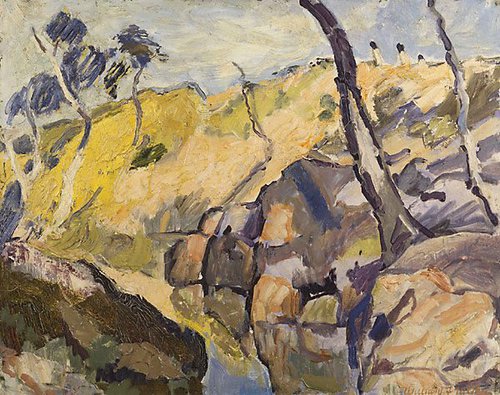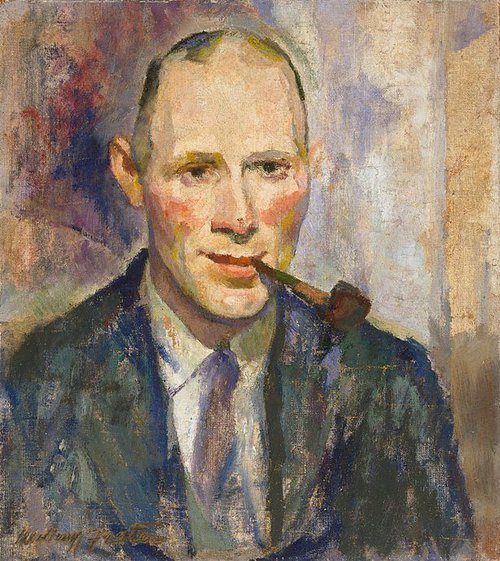William Frater
Scotland, Australia
Born: Scotland 31 Jan 1890
Died: Melbourne, Victoria, Australia 28 Nov 1974
Biography
William ‘Jock’ Frater was an Australian modernist painter, based in Melbourne, who challenged the conservative views of art in the city at the time. Although he did not enjoy the same success as his Sydney contemporaries Roy de Maistre and Roland Wakelin – perhaps because of his outspokenness – he is now regarded as a pioneer who fostered a change of taste within the community, and his importance as an early modernist is undisputed.
Frater was born in Scotland in 1890. At 15, he began an apprenticeship in the Glasgow glass studio of Oscar Paterson, who encouraged him to enrol at the Glasgow School of Art. He studied painting and drawing there until 1909.
Frater migrated to Australia in 1910 and settled in Melbourne. He accepted a five-year contract in charge of stained-glass design at Brooks, Robinson & Co Ltd, and enrolled in night classes at the Victorian Artists’ Society. He went back to the Glasgow School of Art in 1913 to complete his training in its senior painting classes, returning to Melbourne the following year.
Frater made his living as a stained-glass designer – at first with Brooks, Robinson & Co Ltd, where he resumed his earlier post, then with EL Yencken & Co Pty Ltd – while continuing to paint and exhibit in his spare time. He made trips to the countryside outside Melbourne on weekends, painting in the plein air tradition of the Impressionist and Barbizon schools.
Frater’s lifelong friend and fellow painter Arnold Shore also worked as a stained-glass designer with him at Brooks, Robinson & Co. The pair, along with associates Horace Brandt, Pat Harford and Isabel Tweddle, are credited with establishing a post-Impressionist school of painting in Melbourne.
Frater’s first solo exhibition was held in 1923 at the Athenaeum, Melbourne, and he exhibited with the Twenty Melbourne Painters from the late 1920s, and the Contemporary Group of Melbourne in the 1930s.
For a period during his early painting career Fraser adopted the tonal theories espoused by another Scottish-born Australian artist, leading tonalist painter Max Meldrum, particularly in his portraiture; his work during the 1920s and 1930s was heavily influenced by French artist Paul Cézanne.
In 1925 Frater gave a lecture challenging an earlier lecture by artist Bernard Hall (director of the National Gallery of Victoria and head of its art school), in which Hall had attacked modern art and asserted that art was an imitation of nature, a view widely held in Melbourne at the time. Frater asserted that ‘copying nature is not an art… to copy effects of light tends to destroy form and colour’.
Frater retired from stained-glass designing in 1940, devoting himself to full-time painting, subsidised by teaching for a period, and living frugally. He exhibited in Melbourne and Sydney throughout the 1950s and 1960s and was the president of the Victorian Artists’ Society from 1963 until 1972, exhibiting annually with the group during the last decade of his life. In 1974, the year he died, Frater was appointed an Officer of the British Empire for his services to art.







